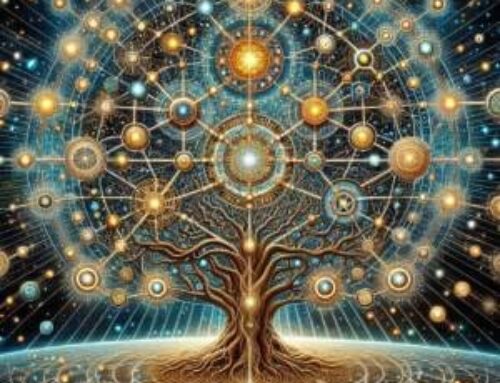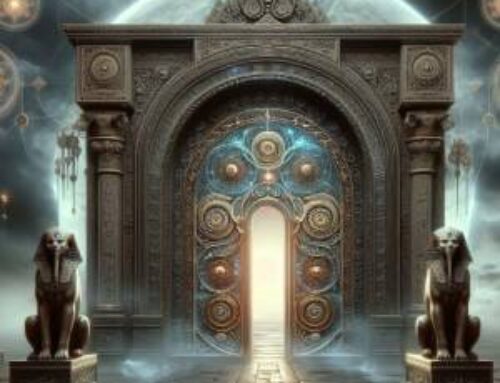Contents
Introduction
Gnostic philosophy offers a profound spiritual path that emphasizes personal experiences with the divine and the uncovering of hidden truths. This tradition invites seekers to engage deeply with the mystical aspects of existence, promoting a transformative journey towards enlightenment. Rooted in ancient traditions, Gnostic philosophy provides a framework for understanding the universe and our place within it. By delving into its teachings, seekers can uncover the secrets of existence and the divine, leading to a more profound connection with the spiritual realms.

The Tree of Life in Gnostic Philosophy
Understanding the Tree of Life
The Tree of Life is a central symbol in Gnostic philosophy, representing the structure of the universe and the path to divine knowledge (1). It consists of ten spheres, or Sephiroth, each representing different aspects of existence and consciousness. These spheres are interconnected by 22 paths, forming a comprehensive map of spiritual reality.
The Tree of Life symbolizes the journey from the earthly realm to the divine, illustrating the stages of spiritual development. Each Sephirah represents a specific stage or aspect of the journey, providing a roadmap for seekers to follow as they ascend towards higher states of consciousness.
The Spheres and Their Significance
Each sphere, or Sephirah, on the Tree of Life holds unique qualities and functions:
- Kether (Crown) – The highest point, representing pure consciousness and unity with the divine.
- Chokmah (Wisdom) – The masculine aspect of divine energy.
- Binah (Understanding) – The feminine aspect, embodying the process of creation.
- Chesed (Mercy) – Represents love and compassion.
- Geburah (Strength) – Embodies judgment and severity.
- Tiphareth (Beauty) – The center of the Tree, representing harmony and balance.
- Netzach (Victory) – Symbolizes eternity and the perpetuation of existence.
- Hod (Glory) – Reflects intellectual clarity and communication.
- Yesod (Foundation) – The connection to the subconscious and the astral world.
- Malkuth (Kingdom) – The physical world and human experience.
The Pathways of Spiritual Ascent
The paths connecting the Sephiroth illustrate the journey of the soul through different stages of spiritual development. They symbolize the challenges and lessons one must encounter and overcome to reach higher states of awareness. Each path has its unique qualities and energies, contributing to the holistic development of the soul. For example, the path between Kether and Chokmah represents the initial outpouring of divine wisdom, while the path between Tiphareth and Yesod embodies the balance between higher consciousness and the subconscious mind.
The Role of Emanations in Gnostic Philosophy
The Concept of Emanation
In Gnostic philosophy, emanation refers to the process by which the divine essence flows from the infinite source into the finite realms. This process is essential for understanding how the divine interacts with the material world and how spiritual realities manifest in physical forms. Emanations are seen as steps in the unfolding of the divine plan, each level bringing the divine light closer to the material world.
The Ten Emanations
The ten Sephiroth are considered emanations of the divine, each reflecting a different aspect of the infinite:
- Malkuth (Kingdom) – The physical world and human experience.
- Yesod (Foundation) – The subconscious mind and dreams.
- Hod (Splendor) – Intellect and thought processes.
- Netzach (Victory) – Emotions and instincts.
- Tiphareth (Beauty) – Harmony, compassion, and balance.
- Geburah (Strength) – Discipline, power, and severity.
- Chesed (Mercy) – Love, kindness, and expansion.
- Binah (Understanding) – Insight, intelligence, and contemplation.
- Chokmah (Wisdom) – Intuition, inspiration, and the creative impulse.
- Kether (Crown) – The highest level of divine light and unity.
These emanations illustrate the descent of divine energy from the highest, most abstract levels down to the concrete physical reality, creating a bridge between the divine and the human.
Balancing the Emanations
Balancing the energies of the Sephiroth is crucial for achieving spiritual harmony. This balance allows for a holistic integration of the physical, emotional, intellectual, and spiritual aspects of one’s being, leading to a more profound connection with the divine. Practitioners of Gnostic philosophy work to harmonize these energies within themselves, aligning their own inner Sephiroth with the cosmic order.
Practical Applications of Gnostic Philosophy
Meditation and Contemplation
Meditation is a fundamental practice in Gnostic philosophy, helping individuals to connect with the divine and explore the inner dimensions of their soul. Contemplative exercises often focus on visualizing the Tree of Life and the flow of divine energy through its pathways. These meditative practices are designed to awaken the inner senses, allowing practitioners to perceive the deeper spiritual realities beyond the physical world.
Through meditation, individuals can access higher states of consciousness and receive divine insights (2). Contemplative practices also involve the use of sacred texts and symbols, which serve as gateways to the divine realms. By regularly engaging in these practices, one can cultivate a deeper connection with the divine and progressively awaken to higher states of consciousness.
Rituals and Symbolism
Rituals in Gnostic philosophy are designed to align the practitioner’s energy with the divine emanations. These rituals often involve the use of symbols, sacred geometry, and invocations to invoke the presence and guidance of higher spiritual forces. Through ritual, practitioners can create sacred space, connecting with the energies of the Sephiroth and invoking their influence in their lives. Rituals also serve to purify the mind and spirit, preparing individuals for deeper spiritual work.
Symbols and rituals play a crucial role in Gnostic philosophy, as they help bridge the gap between the physical and spiritual realms. By engaging with these practices, individuals can tap into the divine energies and facilitate their spiritual transformation. Rituals also foster a sense of community and shared purpose, as practitioners come together to honor the divine and support each other on their spiritual journeys.
Practical Gnosticism
Practical Gnosticism involves applying the teachings and principles of Gnostic philosophy to everyday life. This can include using spiritual wisdom to solve personal problems, enhance well-being, and foster deeper relationships. Practical Gnosticism emphasizes the importance of ethical living, personal integrity, and the continuous pursuit of spiritual growth. It encourages practitioners to apply the insights gained through meditation and ritual in practical ways, improving their daily lives and contributing to the well-being of others.
Conclusion
Gnostic philosophy offers a rich and profound path to spiritual enlightenment, integrating ancient wisdom with modern practices. By exploring the Tree of Life, understanding the process of emanation, and engaging in meditative and ritualistic practices, seekers can unlock the hidden dimensions of existence and connect with the divine. The Hermetic Academy provides a structured approach to studying and practicing Gnostic philosophy, offering guidance and support for those on this transformative journey.
FAQ- Gnostic Philosophy
What is Gnostic philosophy?
A: Gnostic philosophy is a mystical tradition that combines the esoteric wisdom of Gnosticism with the teachings of Kabbalah. It focuses on direct personal experiences of the divine and unlocking hidden truths of the universe.
2. How does the Tree of Life relate to Gnostic philosophy?
A: The Tree of Life is a central symbol in Gnostic philosophy, representing the structure of the universe and the path to divine knowledge. It consists of ten spheres (Sephiroth) and 22 paths, forming a comprehensive map of spiritual reality.
3. What are the ten Sephiroth?
A: The ten Sephiroth are emanations of the divine, each reflecting a different aspect of the infinite. They include Kether (Crown), Chokmah (Wisdom), Binah (Understanding), Malkuth (Kingdom), and others, each representing different aspects of existence and consciousness.
4. How can I practice Gnostic philosophy?
A: Practicing Gnostic philosophy involves meditation, contemplation, rituals, and practical applications of its teachings. The Hermetic Academy offers guidance and support for those interested in exploring and practicing Gnostic philosophy.
5. Where can I learn more about Gnostic philosophy?
A: For more information and in-depth study of Gnostic philosophy, the Hermetic Academy provides resources, courses, and mentorship. It is an excellent place to deepen your understanding and practice of this mystical tradition.
References
(1) Rubenstein, E. (2020). The Tree of Life: The Kabbalah of Immortality. Hermetic World, Paphos.
(2) Rubenstein, E. (2023). Alchemy: Secrets of Consciousness Transformation. Hermetic World, Paphos.





